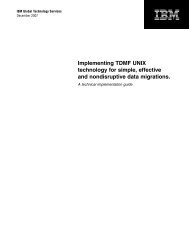A Primer for Healthcare Managers - IBM
A Primer for Healthcare Managers - IBM
A Primer for Healthcare Managers - IBM
Create successful ePaper yourself
Turn your PDF publications into a flip-book with our unique Google optimized e-Paper software.
Per<strong>for</strong>mance management is the central theme of<br />
the working relationship between client and vendor.<br />
Previously ignored, in<strong>for</strong>mation assurance is now<br />
a critical dimension of per<strong>for</strong>mance. The collection<br />
of reliable per<strong>for</strong>mance data, monitoring, and<br />
communication are three indispensable components<br />
of per<strong>for</strong>mance management. Per<strong>for</strong>mance data<br />
need to be collected based on the per<strong>for</strong>mance<br />
matrix developed in the service-level contract at the<br />
contract negotiation stage. Collection of data related<br />
to assurance in<strong>for</strong>mation should include<br />
the documentation of security breach incidents,<br />
commonly referred to as incident reporting. Service<br />
uptime, response time, and user satisfaction are<br />
some good indicators of service quality.<br />
Monitoring should be done at least on a daily basis.<br />
The outsourcing management team needs<br />
to monitor the key per<strong>for</strong>mance measures daily,<br />
including security per<strong>for</strong>mance. There should be<br />
some triggers in place to alert IT service managers<br />
of security vulnerability and poor per<strong>for</strong>mance.<br />
Quarterly and annual reports help identify trends and<br />
patterns. The team should measure per<strong>for</strong>mance<br />
against the level of user satisfaction. Periodic review<br />
of per<strong>for</strong>mance reports and the refinement of the<br />
monitoring mechanism should be part of per<strong>for</strong>mance<br />
management routines.<br />
Frequent communication is another key to successful<br />
management of an IT outsourcing project. Client<br />
organizations and vendors need to communicate<br />
technical and management issues associated with<br />
the outsourced IT services. They can update each<br />
other in an ongoing ef<strong>for</strong>t to improve services or<br />
jointly resolve management concerns.<br />
A management team and structure need to exist<br />
during implementation of IT outsourcing contracts.<br />
One common problem with IT outsourcing projects<br />
is the lack of management support in dealing with<br />
ongoing problems. The outsourcing arrangement<br />
needs constant management and input of resources.<br />
A management team needs to be in place to keep<br />
the implementation consistent with the contract and<br />
to make sure the objectives are in line with the strategic<br />
goals of the organization. A stable management<br />
structure will help resolve any related technical and<br />
management concerns.<br />
The deliverables in this phase are the per<strong>for</strong>mance<br />
review report and project plans <strong>for</strong> constant service<br />
improvement. A per<strong>for</strong>mance review should be done<br />
periodically with assessment of per<strong>for</strong>mance to see<br />
if a vendor is meeting service requirements. Project<br />
plans <strong>for</strong> service improvement include a service<br />
needs assessment project, methods to address<br />
service problems, and detailed steps to solve a<br />
service problem.<br />
Phase 5: Best Practices<br />
• Take a collaborative approach. A management<br />
system based on the principles of open<br />
communication and collaboration helps identify<br />
service needs and improve service quality.<br />
• Collect and monitor per<strong>for</strong>mance in<strong>for</strong>mation.<br />
A per<strong>for</strong>mance matrix needs to be in place, and<br />
the per<strong>for</strong>mance data should be communicated<br />
to the agency on a regular basis.<br />
• Be adaptive to change. New service needs<br />
are likely to arise. Based on the collaborative<br />
model, public agencies and vendors can work<br />
together to turn change into an opportunity <strong>for</strong><br />
service improvement.<br />
Recommendations<br />
IT outsourcing can be rewarding if properly<br />
managed. IT outsourcing is emerging as a way of<br />
meeting the demand <strong>for</strong> the quick deployment of<br />
advanced technology. Access to skilled personnel,<br />
advanced technology infrastructure, flexibility, and<br />
cost savings are all driving <strong>for</strong>ces <strong>for</strong> outsourcing.<br />
However, managers face challenges when trying<br />
to fully realize the potential of IT outsourcing. Loss<br />
of control, instability of vendors, and complexity in<br />
managing an outsourcing contract are some of the<br />
barriers often cited.<br />
The process model offered in this report gives<br />
managers a framework <strong>for</strong> the in<strong>for</strong>med management<br />
of IT outsourcing. This framework is designed<br />
to maximize the benefits while minimizing the risks<br />
involved, which can be accomplished by following<br />
both the general and phase-specific recommendations.<br />
General recommendations offer generic<br />
guidelines <strong>for</strong> the successful management of an IT<br />
outsourcing project from its very beginning. Phasespecific<br />
suggestions offer more in-depth guidelines<br />
<strong>for</strong> maximizing benefits.<br />
<strong>IBM</strong> Center <strong>for</strong> <strong>Healthcare</strong> Management 19

















